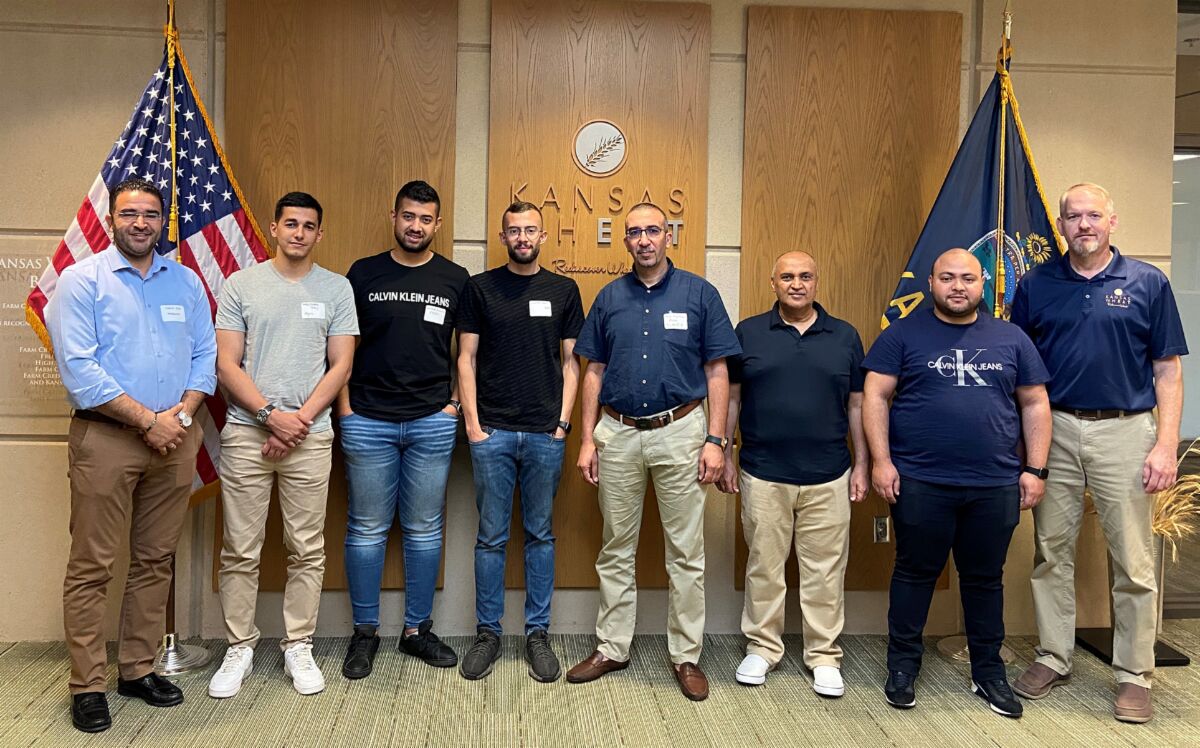Members of the next generation of flour millers and commodity buyers from operations in Morocco, Algeria, Egypt and Oman discussed the science behind the hard red winter wheat crop as part of a 12-day tour to Idaho, Kansas and North Dakota.
The team, organized by U.S. Wheat Associates, was comprised of future industry decision-makers. Some attendees were students and had part-time jobs in their family’s flour mills to prepare them to take over from their parents. USW used this opportunity to introduce information about the U.S. grain marketing system at an early stage in the careers of these young professionals and build strong relationships to lay the foundation for future opportunities like potential combination cargos.
“These young generation millers represent their family businesses and are exposed to the U.S. grain marketing system at a very early age,” said Tarik Gahi, milling and baking technologist in the USW office in Casablanca, Morocco, who accompanied the team. “Visits to different states on this trip were an opportunity to introduce different classes of U.S. wheat and learn about efforts implemented by organizations and facilities to produce the best quality wheat.”
Overall, the Middle East/North African region imports primarily HRW wheat in addition to soft white (SW) and soft red winter wheat. However, the region is composed of more than 30 countries, meaning there is a wide variation in the sophistication of local flour milling operations and wheat importation.
Egypt is the world’s largest wheat importer due to high per capita consumption, driven by government flour and bread subsidies. While the country imports from multiple origins, the largest market share is traditionally given to Black Sea suppliers.
In the MAGHREB countries (Algeria, Libya, Mauritania, Morocco and Tunisia), imports depend heavily on domestic wheat production as well as crop quality from geographically closer suppliers. As a result, U.S. wheat exports to these countries fluctuate greatly from year to year, although these countries are consistent buyers of U.S. durum.
Taking advantage of market opportunities in the Middle East/North African region requires a long-term commitment to building relationships within the industries of individual markets, like the up-and-coming leaders of the young millers team. As part of this work, USW organizes in-person tours to the United States to provide firsthand insights into the current year’s wheat harvest. Kansas Wheat staff regularly participates in these programs to provide personalized information to each market and receive feedback directly from customers.
From July 17 to July 20, the team spent time in Kansas learning about HRW production, visiting research facilities and meeting with leading wheat researchers. At the USDA Center for Grain and Animal Health Research, the team discussed how USDA scientists in the Hard Winter Wheat Genetics Unit focus on different diseases that affect the wheat plant, including leaf rust, stem rust or Fusarium Head Blight. They also discussed how both basic and applied research help ensure a high-quality U.S. grain supply by evaluating the end-use of breeding lines through biochemical and physical characterization.
The team toured the Grain Science Complex on the north campus of Kansas State University, including the Kansas Wheat Innovation Center, IGP Institute and Hal Ross Flour Mill. Participants received an overview of how U.S. wheat classes are graded, including a hands-on grading practicum. The team also visited Research Productions Company in Salina, which provides innovative ideas, services and products for the milling and baking industries.
The team left with a greater understanding of the science behind HRW development in Kansas and the commitment of U.S. wheat producers to continue to grow the world’s most reliable supply of high-quality wheat. Both lessons will stick with these young leaders throughout their burgeoning careers and contribute to future sales of U.S. wheat.
Learn more about how USW works with wheat buyers around the world or track commercial sales at https://www.uswheat.org/.


